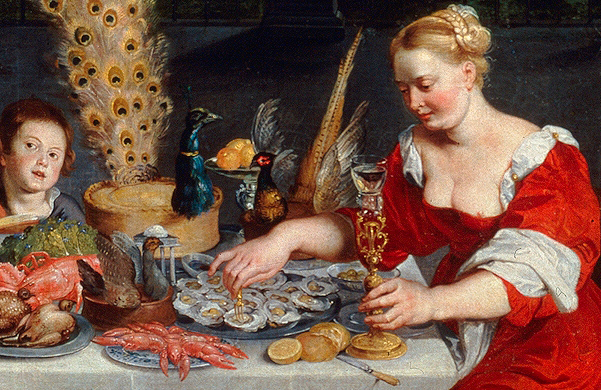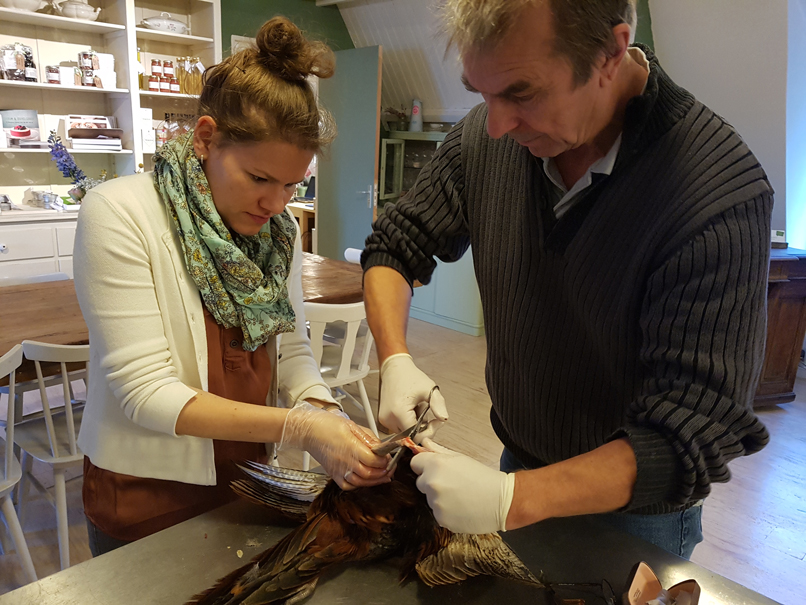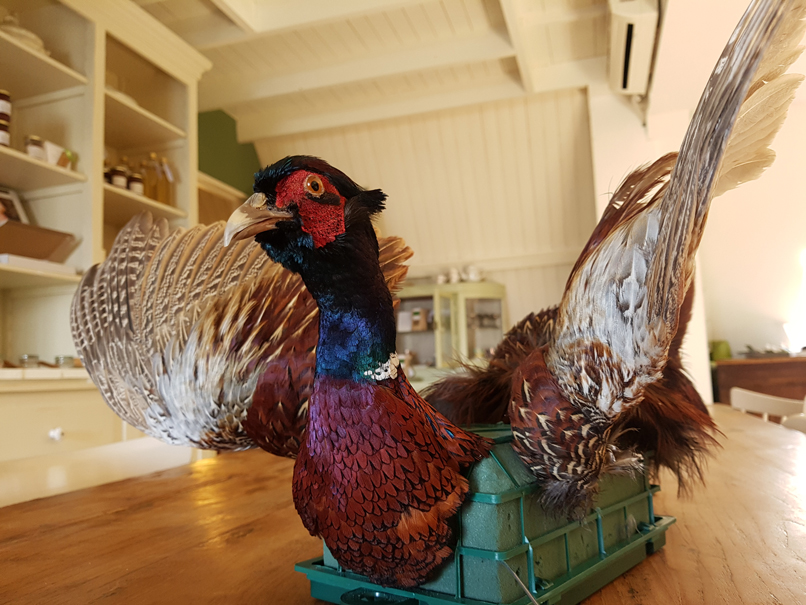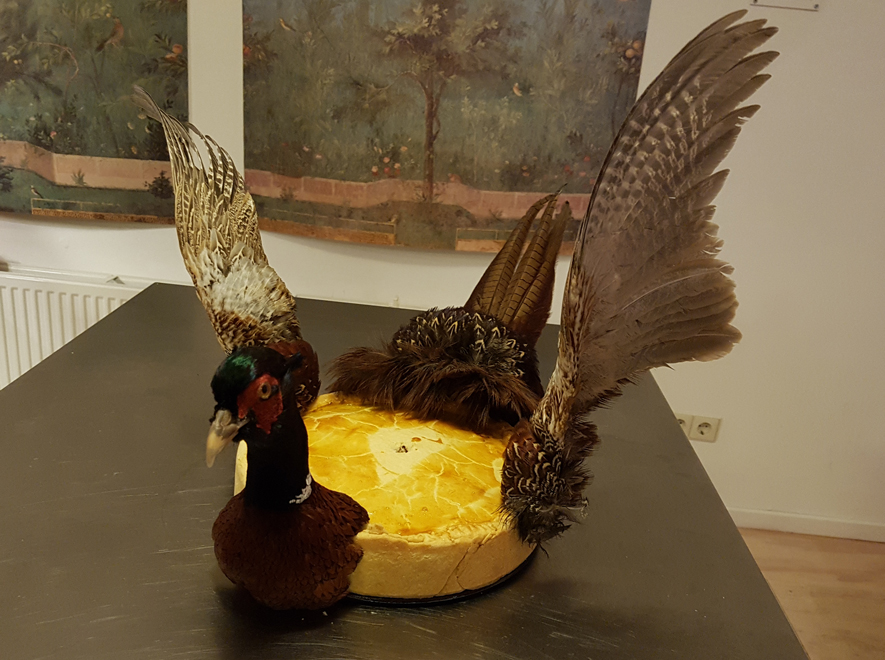There are many 16th and 17th century paintings that show beautiful pies with magnificent exotic birds on top. There are only just a few recipes that tell us how they were prepared exactly. This lack of information has made me curious about how they made these kinds of pies. And of course, I am also curious about what they would have tasted like. Only one thing left to do: make one!

Pheasant pie
When I got the idea to make several historical pies with birds on top, it seemed like a good idea to me to start with a bird cooked before: a pheasant. I prepare historical recipes for pies all the time, like a surprising pheasant-marzipan pie from the 16th century. But to prepare the head, tail and wings of the bird like on the paintings seemed more like a task for the experts. So, I went to the experts at the natural history museum De Bastei in Nijmegen. They do a lot of taxidermy for the museum and they were very willing to prepare the bird as on 17th century paintings.
Preparing a pheasant this way was completely new to them, but they were very excited to help. I got a magnificently beautiful pheasant cock from my poulterer, which was expertly skinned by the people of the museum. They took the feathers with them and stuffed the bird in four separate parts: the head, tail and two wings

The pheasant’s meat was used in a cooking class to make a delicious dish, based on a recipe by Antonius Magirus (1612) from the book Koockboec oft familieren keukenboec. This recipe tells you in beautiful old Dutch how to prepare a pheasant. It says that it has to be done around the beginning of October until February. When you kill a pheasant, you are supposed to leave it for six whole days in the winter and just one and a half in summer. After this time period, you pluck it and remove all the intestines. When you’re done with this, you can stuff it and cook it. It also says that you can prepare other birds the same way as well.
Hoe dat men faisanten braden sal. Den tyt van de faisanten begint van ‘t beginsel van october, ende duert de heel maent van februarius. Dese voghels naerdat gedoot syn, moet men laten ligghen met de pluymen ende met hun ingewant den tyt van ses daghen in den winter, ende in den somer anderhalven dach, dan pluckt mense drooch, men snyt de vleugels af, ende treckt hun d’ingewant uut, ende men strootter van binnen wat souts, venckel, ende peper. Wilt mense vullen met eenighe van de voorseyde vulsels, dat mach men doen, maer die se heel schoon in ‘t gesicht begeert ende ooc met eenen lieffelycken smaeke, die moetse eenen clont speckx int lyf steken, ende dien wel gelardeert met naghelen ende venckel, naeyt dan de opening toe, ende snyt de pooten af, oft sommige latenser aen, steckt dan de borste vol naghelen, ende neempt twee stucken speckx niet dicker als eenen rugghe van een mes, ende soo lanck als den faisant is, wentelt die wel in sout en venckel, ende bintse d’een op den rugge, d’ander op de borst, soodat hy met dit speck bedeckt sy, neempt dan een blat pampier, wel met vet oft boter besmeert, ende bindt er dat om, ende steecktse soo aen den spit, ende laetse braden aen een lansaem vier, gebraden synde, doet het pampier met het speck af, ende dientse ter tafelen met sap van aranien ende wat souts. Men cander ooc eenige sauce over maken, is op allebeyde manieren seer goet. Op dese maniere van den faisant mach men den capuyn oft kiekenen ooc braden, ende ander diergelycke vogels.
Pheasant from head to tail.
The curators brought the finished pheasant to my cooking studio. They really turned it into a work of art, he really looks lifelike. I felt for days that someone was watching me! I mostly eat vegetarian dishes. So this project is a bit confronting. The challenge for me lies in understanding what it means to eat animals, and learn how to use every little bit of an animal. I am a big proponent of eating the whole animal, not just certain bits and pieces. Luckily, old cooking techniques are finding their way back into modern cooking. I carefully introduce them to my cooking classes as well. I have to be careful because most people are taken back by having to cook a whole bird or an ox tongue, for instance. The wonderful thing about my cooking classes is the fact that almost everyone is interested and eventually tastes whatever was cooked. It feels very good to teach people something new, even though it is an old tradition that got out of fashion.

Recipes for pheasant pie
Antonius Magirus gives us two more recipes for pheasant pie. The first one is almost a literal copy from a pheasant-marzipan pie from the cookbook Opera dell’arte del cucinare of the Italian chef Bartolomeo Scappi (1570). The second one looked even tastier than the first one.
In this second recipe, he tells you to take the pheasant’s breast and bake it until it is halfway done. When you’ve done this, you need to mix it with other ingredients and grind it all into a tender filling for the pie. Above all, you need to make sure there are no lumps left. You can add apple juice, eggs, breadcrumbs, etcetera. The recipe also tells you that you can decorate it with edible flowers, some nuts or leftover dough. In the end, you’re supposed to sprinkle the pie with cinnamon and sugar.
Toert met borstvlees van fazant. Neempt het spier oft borst van de faisanten half gebraden, oft van ander diergelycke gevoghelte, stootse in eenen mortier, met een pont amandelen, ende een half pont versche verckensliese, oft in plaetse van dien, ossenmerch oft ooc vers vet van eenen capuyn, een half pont pingelen, eerst wat gheweyckt, vier oncen versche dayen, de steenen uutgedaen. Naerdat dit wel gestooten sal wesen, soodatter niet clontachtich meer in en is, tot meerder versekeringhe passeert het door eenen groven tempst, doet ter dan by ses rouw doyeren van eyeren, wat geraspt broot, ende boter, anderhalf pont suycker, dry oncen sap van appelen uutgeperst, een once gestooten canneel, anderhalf once tusschen noten, naghelen, gember, maeckt hier dan u toerte af, sal seer delicate wesen, moochtse ooc dienen cout oft warm, soo’t u belieft, met suycker ende canneel, daerover.
Boy, oh boy, this was such a tasty pie! Even without a pheasant like ours, you can make a delicious pie using this recipe. I chose to use the whole pheasant instead of only the breast. The pie becomes a lot juicier and this way you can use the whole animal. If pheasants are not in season you can use a nice and tender (organic) chicken as well.

Ingredients
Dough
50 grams of flour
250 grams of butter
Pinch of salt
A few spoonsful of water
Filling
2 whole pheasants (cleaned)
200 grams of almonds
100 grams pine nuts
150 grams dates
100 grams lard
4 egg yolks
2 handful’s bread crumbs
100 grams of soft butter
300 grams of sugar
100 ml of orange juice
4 tsp cinnamon
2 tsp cloves
2 tsp nutmeg
2 tsp ginger
Cinnamon and sugar
Preparation
Put the flour and butter in a bowl and chop the butter into small pieces using a knife. Add salt and water and quickly knead it into a dough. Let the dough rest in the fridge while you make the filling for the pie.
Cut the pheasant into pieces. Fry the pheasant in butter until it is halfway done. Get the meat off the bone and put it into the food processor. Add the almonds, pine nuts, dates and lard. Grind it into a coarse mixture. Put it into a bowl and add the egg yolks, bread crumbs, butter, sugar, orange juice, cinnamon, nutmeg, cloves and ginger. Mix well.
Line a baking tin with 2/3 of the dough and put the filling in. Make a lid of the rest of the dough to cover the pie. You can make decorations from the leftover dough and give the lid an egg wash. Bake the pie in a preheated oven for 45 minutes at 200°C.

